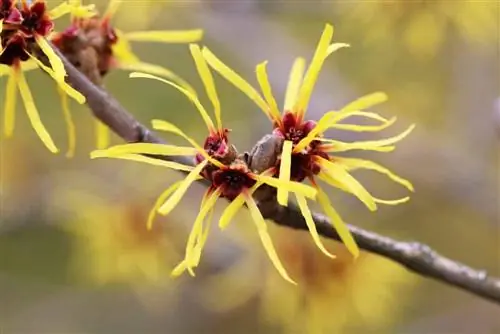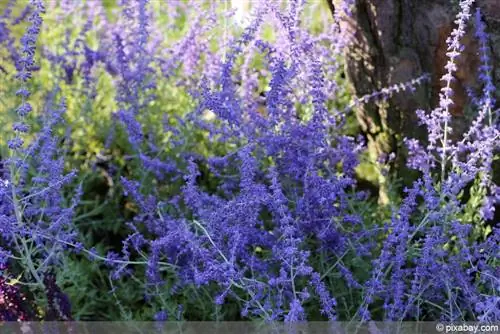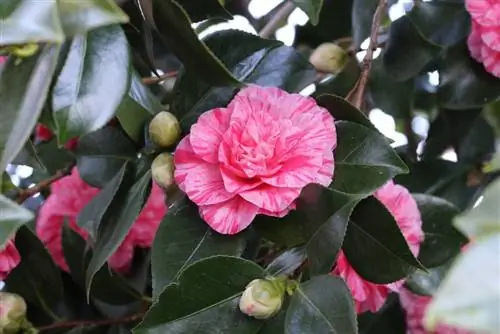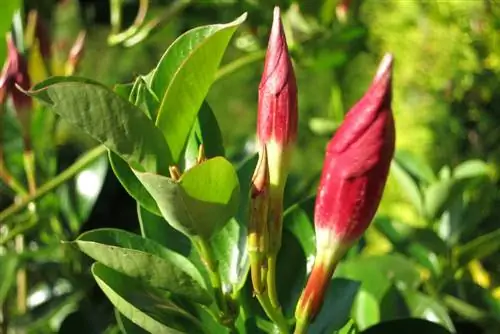- Author admin [email protected].
- Public 2023-12-17 03:39.
- Last modified 2025-06-01 06:48.
The witch hazel or witch hazel is a deciduous shrub that is one of the few winter-flowering plant species and stands out due to its unusual flower shape. Since witch hazel requires a long growing time and the shrub's growth habit can easily be destroyed, timing and pruning are very important for the plant.
When is the best time to cut the witch hazel?
Compared to other plants, cutting any of the five varieties of witch hazel is not typically done in summer or spring. It is one of the few plants that is in full bloom in winter and, like other trees and shrubs, loses its leaves in autumn. For this reason they are a popular ornamental plant, especially as a solitary plant, although it takes a few years to reach its full size of around five meters wide.
It is interesting to see that witch hazel does not require much care to maintain attractive growth and almost no pruning is required. Above all, proper pruning should not be done as this would damage the shape. However, the following types of pruning are used to enable the “witch hazel”, as it is called in English, to grow he althily:
- Blending
- Topiary
- Rejuvenation cut
- Regular Care
When do you have to thin out witch hazel species?
Magic nuts are very robust and are one of the shrubs that almost never need pruning. The species completely avoids any real pruning and therefore only rarely needs to be thinned out. Thinning is particularly important if you can find dead shoots, sickly areas or root sprouts on the witch hazel that would disrupt the growth of the plant. The best time for thinning is immediately after flowering, which occurs at a different time depending on the species:
- Hamamelis virginiana: Autumn
- Hamamelis vernalis: Winter
- Hamamelis japonica: Winter
- Hamamelis mollis: Winter
- Hamamelis ovalis: Winter
- Hybrid Witch Hazel: Winter
For this reason, you must pay attention to which species is in your garden before thinning out. Cutting a witch hazel species correctly only happens if the right time is chosen. Hamamelis virginiana is also known as Virginian or autumn-flowering witch hazel. This allows you to prune at the right time without worrying about disturbing the plant while it blooms. You should thin out the root trunks in autumn. Important: here you only remove the root spawn.
When does topiary happen?
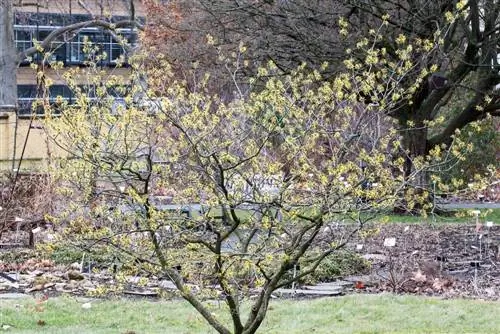
Due to the very low growth, around 20 centimeters per year, it can take years before a topiary needs to be done. The topiary is not a real topiary, but rather a careful trimming of the existing plant. Since witch hazel can lose its shape or become too large over the years, this cut is sometimes necessary. Topiary pruning is carried out after flowering, at the same time as thinning.
When does rejuvenation pruning for older plants take place?
As with many other types of shrubs, a neglected witch hazel can be prone to uncontrolled growth, affecting the plant's vitality and natural shape. It is very robust and undemanding to care for, but some specimens, especially those exposed to strong winds in winter and too little sun in summer, need a rejuvenation cut.
This should also happen after flowering and ensures that the witch hazel starts growing again in a species-appropriate manner the following year. However, you must assume that after such a project the shrub will have to grow for several years to regain its full size. Therefore, this cut should only be used in an absolute emergency and on a sickly, old plant.
Regular Care
Proper cutting is only partially necessary in some years when the growth is good, but a witch hazel is always happy with enough attention. You can remove dried branches or dead leaves all year round, keeping the shrub fresh and he althy.
Instructions for thinning out the witch hazels - explained step by step
Since witch hazel is very sensitive to cuts, it is important to cut correctly so as not to damage the plant. Follow the steps and you will allow the witch hazel to grow comfortably without being restricted.
- Hamamelis is sensitive to all kinds of cuts and therefore requires a sharp, clean tool. Use pruning shears that are suitable for young shoots and clean them before cutting if necessary. Please note: Scissors that have been used to cut other plants in particular need to be cleaned. This is the only way to protect the shrub from a
- Since the branches with the flowers on the witch hazel can be easily identified, you can immediately see which shoots need to be carefully removed. Inspect all shoots with flowers carefully, because due to the size of the witch hazel in later years, you will have to examine them carefully so as not to remove shoots that are too old.
- When cutting, you must be particularly careful and avoid cuts. Remove only as much as is necessary to maintain he althy shoots.
- Remove any shoots that are too weak or dried out. These would only hinder the growth of the shrub.
- Next, look for shoots that are crossing each other. Remove the shoot that goes against the shape and expose the other shoot. This helps the witch hazel maintain its shape. This also stimulates growth.
- After cutting, you should remove the cut parts of the plant and cover the shoots with a fleece, especially in young specimens. This is only necessary if you live in a very cold climate or the shrub's location is affected by strong winds.
- During annual care, proceed in the same way as thinning, only cut off the dried, weak or broken shoots.
- The root spawn is thoroughly removed with a simple cut.
The topiary - instructions in detail
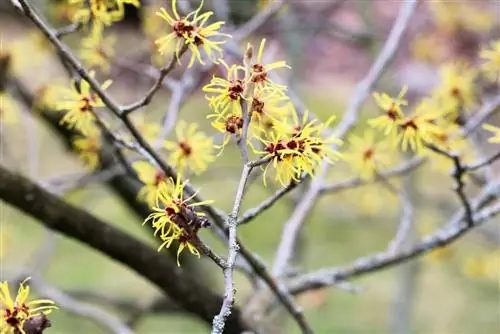
While thinning specializes in the care of individual shoots, topiary is used to reduce the size of the bush or to trim shoots that are too long. You should be particularly careful here so as not to harm the plant.
- Also use sharp secateurs that have been thoroughly cleaned beforehand.
- The topiary is done on all shoots that have flower buds. Locate these and make the cut there. Please note: This does not mean the leaf buds.
- Cut back two buds of last year's growth. Leave as many flower buds as possible.
- Always pay attention to the shape when cutting. If a bare spot appears on one side when cutting to shape, do not cut there. The shrub would suffer and not recover for years. It is typical for the witch hazel that after a topiary the size was only reduced slightly. This is necessary to keep them from wasting away.
- Remove the removed green here too. Winter care is not necessary after topiary.
The rejuvenation cut with instructions
You should only use the instructions for rejuvenating pruning if your witch hazel species is suffering from age or a lack of care.
- Use secateurs that are suitable for thicker branches. Again, make sure that the scissors are sharp and clean.
- Measure 15 to 25 centimeters from the base of the plant. This is the length to which you trim the witch hazel.
- Now shorten the main shoots to the measured length.
- Remove buds, root shoots and sprouts on the main branches that appear below the measured length.
- Then shorten all other shoots back to two buds.
- Then remove all plant material and allow the plant to rest.
What mistakes you should avoid during editing
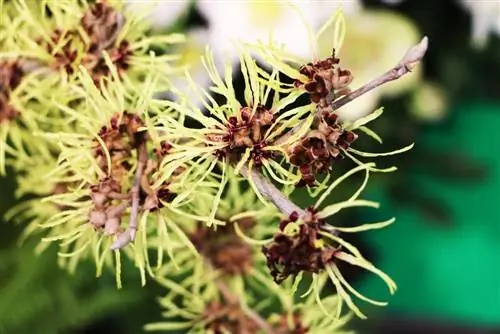
Cutting witch hazel correctly means not cutting too much. With every cut and regular care, always make sure to remove as little of the shoots as possible. With just one cut too many, the witch hazel could wither and then need to be rejuvenated. If you take a lot of time when cutting, you will get the best results.
There are signs throughout the year if the shrub has been over-trimmed or injured during pruning. If the following symptoms occur, rejuvenation pruning may be necessary, which will delay the entire growth of the plant by years:
- Sleeping buds (proventive buds) are increasingly appearing
- No longer sprouts from old wood
- Exploring slowly
These signs are always unfavorable for witch hazels and cause weak growth, which even leads to the plant becoming stunted. So pay more attention to these points.
Furthermore, it is important to only prune the youngest shoots when making a cut. Never cut into the thick branches that are in full sap and are among the oldest parts of the plant. Pruning is not well tolerated by witch hazel and can lead to a variety of problems, most notably the regular loss of shoots and flowers. Don't be afraid if the flowers don't bloom in winter or autumn.
Hamamelis will not produce flowers if the summer was too dry and there was little rainwater. In this case, the cut is not to blame. Just wait until next year and hope for enough summer rain.
Witch hazel flowers withered? What now?
After flowering, the individual flowers say goodbye very quickly and are disposed of by thinning out. If wilted flowers appear during the flowering period, they should not be removed until thinning takes place. Simply leave them on the witch hazel until you cut it. You could accidentally damage the shoots and thereby permanently ruin the growth.

